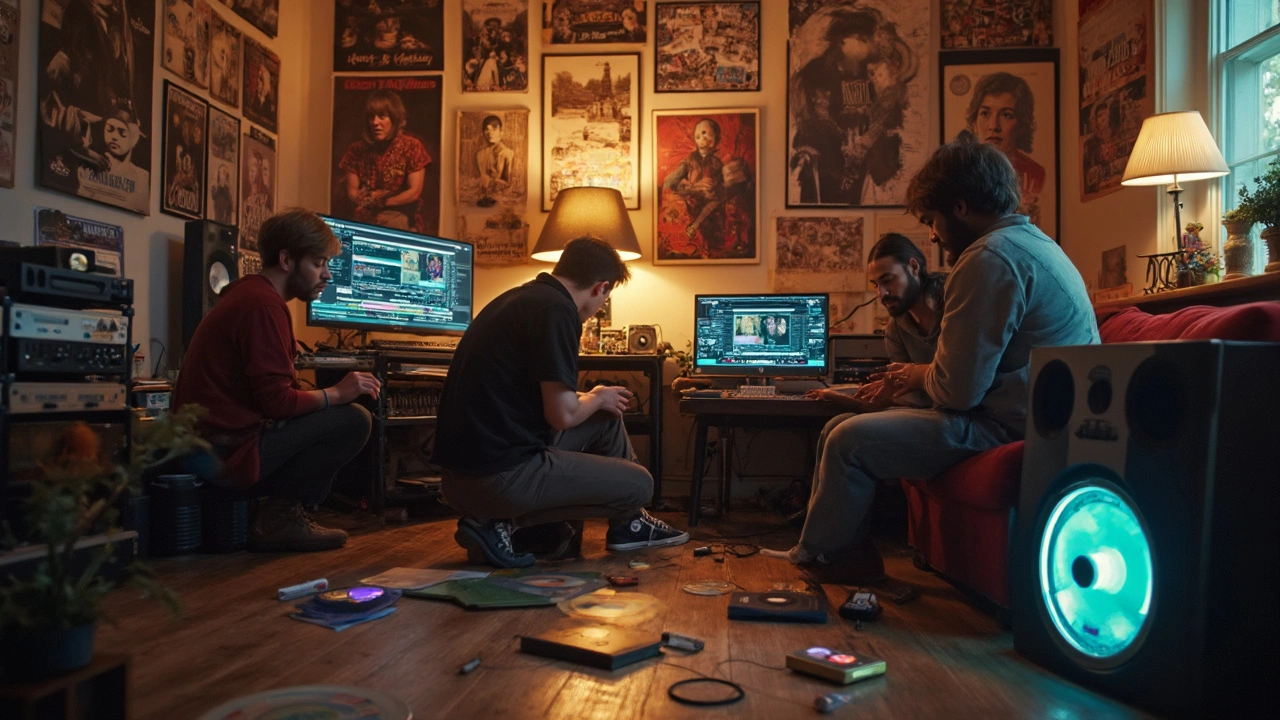If you think pop, hip-hop, or electronic music all started out the way they sound today, you’re in for a surprise. Every shift in music genres usually comes right after a wave of new technology, whether it’s a home-recording setup in someone’s bedroom or someone messing around with AI generated beats. Producers and artists jump on anything that lets them create something fresh or unexpected, and pretty soon the rest of us are streaming a whole new sound.
Take hip-hop, for example. It all started with turntables and sampling. Then drum machines like the Roland TR-808 changed everything, making those famous booming beats. Fast-forward to now, and anyone can make a track on a laptop—even using sounds that never existed before. If you’re paying attention, you’ll notice that every big jump in sound happens because someone tries a new gadget or software, and it clicks with fans.
- When Tech Changes the Beat
- Genre-Bending in the Digital Age
- Streaming and Social Media’s Huge Impact
- Tips for Staying Ahead: Making the Most of Tech in Music
When Tech Changes the Beat
Every big shift in music genres usually springs from a new piece of gear or tech. Remember when electric guitars first hit the scene in the 1950s? That wasn’t just about playing louder; it gave birth to entire genres, like rock and roll and later heavy metal. Then came synthesizers in the late 1960s and 1970s, and suddenly you had electronic music and new wave taking over radios and dancefloors.
Turntables and mixers opened the door for hip-hop. DJs in the Bronx started scratching records, building beats that totally changed what music could sound like. By the time drum machines like the Roland TR-808 showed up in the '80s, those deep, punchy sounds were everywhere—in rap, pop, even in early techno.
Fast forward to the 2000s: digital audio workstations (DAWs) like Ableton Live and FL Studio made it possible for anyone with a laptop to become a producer. No expensive studio needed. Artists from their bedrooms started mixing, sampling, and editing with tools that the Beatles or Bowie couldn’t have dreamed up. That’s how you get massive hits from people who got their start on YouTube or SoundCloud.
Here’s a quick look at just how much each new tech has changed things:
- Electric Guitars: Turned folk and blues into rock & roll.
- Synthesizers: Shaped disco, electronic, and pop landscapes.
- Drum Machines: Essential in hip-hop, electronic, and pop production since the 1980s.
- DAWs: Lowered the barrier to entry, helping indie and bedroom producers make professional tracks.
- Auto-Tune: Made its mark in both hip-hop and pop, sometimes even creating entire subgenres.
Want some numbers to see the impact? Check this out:
| Tech | Year Introduced | Key Genre Impact |
|---|---|---|
| Electric Guitar | 1936 (commercial) | Rock, Blues, Metal |
| Synthesizer | 1960s | Electronic, Disco, Pop |
| Drum Machine (TR-808) | 1980 | Hip-Hop, Pop, Electronic |
| DAW | Late 1990s | All modern genres |
The bottom line? Every time technology moves forward, it nudges music genres in new directions—sometimes in ways no one expects. It’s why your favorite song last year might already sound old-school today.
Genre-Bending in the Digital Age
Genres used to have clear boundaries. But since everything went digital, mixing genres—or genre-bending—has pretty much become the standard. Thanks to laptops and simple software, artists don’t need fancy studios or huge budgets to play around with sounds from totally different scenes. Billie Eilish records with her brother in a bedroom and mixes pop with electronica and even a little hip-hop. Lil Nas X turned “Old Town Road” into a worldwide anthem by blending country and rap—something that would’ve felt impossible 20 years ago.
Social media and platforms like SoundCloud made it easy to test new sounds. No label exec is breathing down your neck, so you can upload anything, and it might blow up the next day. That’s how genres like bedroom pop, hyperpop, and lo-fi hip-hop became a thing. Sometimes, fans even name the genres themselves.
Digital tools let you grab influences from anywhere: Japanese city pop, UK grime, or old-school rock. Producers love taking a sound from one corner of the globe and mashing it with something from the other side. Want some proof?
| Song/Artist | Genres Combined | Platform or Technology Used |
|---|---|---|
| "Old Town Road" by Lil Nas X | Country, Hip-Hop | SoundCloud, TikTok |
| Billie Eilish's early releases | Pop, Electronica, Alternative | Home studio, Ableton Live |
| 100 gecs | Hyperpop, Punk, EDM | FL Studio, Discord, Bandcamp |
The best tip for anyone making music today? Try stuff that’s not supposed to mix. Use free plug-ins, download samples from odd places, and let algorithms throw weird suggestions your way. There’s a good chance your favorite music genres from the future are just somebody’s wild experiment today.

Streaming and Social Media’s Huge Impact
It’s impossible to talk about how music genres evolve without bringing up streaming and social media. These two have totally flipped how we find and listen to music. Back when CDs and radio ruled, you only heard what was pushed to the top. Now, anyone in the world can upload a track and reach a global audience overnight—no label needed.
Platforms like Spotify and Apple Music have made things super easy. Their technology learns from what you play, so discovery is kind of automatic. These platforms also group tracks by mood or vibe, not just by traditional music genres—think "lofi beats to study," "bedroom pop," or "hyperpop." This has actually led to a ton of genre-blending, because listeners aren’t just sticking to one style.
Social media has added rocket fuel to this trend. TikTok is a perfect example: tracks go viral not because of radio plays, but because they fit a dance trend, meme, or challenge. Songs like "Old Town Road" by Lil Nas X or "abcdefu" by GAYLE blew up on TikTok first. The numbers back this up—a 2023 Statista report showed over 75% of users said TikTok helped them find new songs, and most chart-toppers these days have some viral boost behind them.
| Year | Global Streaming Users (Billions) | TikTok Songs in Top 10 (US) |
|---|---|---|
| 2018 | 0.25 | 2 |
| 2020 | 0.4 | 7 |
| 2023 | 0.6 | 9 |
If you’re an artist or even a fan who wants to see what’s next, it makes sense to keep an eye on social trends. Track what’s popping up in playlists or going viral on Instagram Reels, TikTok, and YouTube Shorts. These are today’s tastemakers, helping turn bedroom producers into global names and pushing genre evolution faster than ever.
Tips for Staying Ahead: Making the Most of Tech in Music
If you want to keep up with how music genres change, you have to keep your eyes on the tech. The way songs get made, shared, and hyped is constantly shifting, so here are some simple but powerful ways to stay at the front of the pack.
- Try Out New Music Software: Don’t just stick to GarageBand or FL Studio if that’s all you’ve known. There’s always something fresh popping up, like Ableton for live performances, or Logic Pro for pro-level sound. New AI tools like Suno and Boomy let you create beats and even lyrics with a few clicks. Just keeping your toolbox updated makes a huge difference.
- Dive into Sampling and Remix Culture: Sampling isn’t just for hip-hop anymore. Pop, EDM, even indie rock producers use samples and loops — and there are tons of legal sample libraries now. Splice is a go-to for songbuilders who want access to fresh sounds every month.
- Understand Streaming Trends: Platforms like Spotify and TikTok have totally changed how music gets discovered. There’s actually a stat from Chartmetric in 2023: over 30% of songs that charted on Spotify’s Global 50 first blew up on TikTok. Pay attention to what’s going viral. It can spark a new direction for your style — or just give you ideas about what sounds new listeners want.
- Collaborate Online: You don’t have to live in LA or London anymore. Musicians now swap tracks, vocals, and ideas with people across the world. Tools like Soundtrap or BandLab let you jam and produce in real time, no matter where your team is based.
| Tool/Platform | Main Use | Why It Matters |
|---|---|---|
| Splice | Sample Discovery | Access thousands of loops and one-shots for endless creativity |
| Soundtrap | Online Collaboration | Create and record music with people anywhere |
| TikTok | Music Discoverability | Viral tunes here often chart everywhere else |
| Suno | AI Composition | Generate beats and lyrics in seconds |
Staying flexible and curious is how you level up with music production and keep pushing into new music territory. Don’t wait for the big industry to tell you what’s cool—jump in, mess around, and let the tech help you make your mark.

